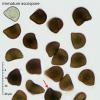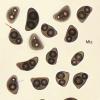
14-11-2025 16:26
 Marian Jagers
Marian Jagers
Hello everyone, On dead wood of Cytisus scoparius

17-11-2025 21:46
Philippe PELLICIERBonjour,Récolté sur bois pourrissant de feuillu

20-11-2025 14:14
Mick PeerdemanFound on the leaves of 'Juglans regia' in the Neth

20-11-2025 13:07
Mick PeerdemanIn January i found these black markings on the dea

20-11-2025 12:38
Mick PeerdemanDear all,Last week i stumbled upon a leaf of ilex

19-11-2025 23:21
 carl van den broeck
carl van den broeck
Dear guestIn Waardamme, Belgium, I found dozens of

19-11-2025 20:51
 Andreas Millinger
Andreas Millinger
Good evening,found this species on a felled trunk

19-11-2025 13:04
 Bruno Coué
Bruno Coué
Bonjour,je sollicite votre avis pour la récote

16-11-2025 21:09
 Robin Isaksson
Robin Isaksson
Anyone recognize this acc. to pictures.? Found on
Enigmatic pyrenomycete
Enrique Rubio,
01-01-2025 13:45
THE ASCI ARE CYLINDRICAL, WITH A DOUBTFUL OR INCONSPICUOUS APICAL APPARATUS MLZ. NEGATIVE AND THEY HAVE EIGHT OBLIQUELY UNISERIATE ASCOSPORES. THE PARAPHYSES ARE ABUNDANT, IN SOME CASES WITH MONILIFORM SEGMENTS AND THEY EXCEED THE LEVEL OF THE ASCI.
THE MATURE ASCOSPORES ARE BLACISH BROWN, THEY HAVE AT LEAST ONE GERM PORE (RED ARROW), SOMETIMES TRANSVERSE SEPTA, A COMPLEX SYMMETRIY AND PERHAPS A SHORT GERM-SLIT ONLY WELL VISIBLE IN MELZER'S REAGENT (BLUE ARROW).
I CANNOT FIND AN APPROPRIATE GENUS FOR THIS FUNGUS, NOT EVEN WITHIN THE MELANOSPORALES, SO I AM ASKING FOR SOME CLUE TO SOLVE THIS ENIGMA.
I WOULD LIKE TO TAKE THIS OPPORTUNITY TO WISH YOU A HAPPY NEW YEAR.
Alain GARDIENNET,
03-01-2025 08:17
Re : Enigmatic pyrenomycete
Hi Enrique,
Your fungus should not be too far from Bellojisia rhynchostoma.
Happy new year for you, and forum !
Alain
Your fungus should not be too far from Bellojisia rhynchostoma.
Happy new year for you, and forum !
Alain
Thorben Hülsewig,
03-01-2025 10:48
Re : Enigmatic pyrenomycete
Hi Enrique,
Perhaps you have found Corylomyces selenospora.
best regards,
Thorben
Perhaps you have found Corylomyces selenospora.
best regards,
Thorben
Enrique Rubio,
03-01-2025 12:45
Re : Enigmatic pyrenomycete
Some colleagues had initially pointed me towards Corylomyces and later towards Bellojisia. I think this fungus could belong to the latter genus, because by the morphology of the ascomata, the asci with an inconspicuous apical apparatus and the presence of abundant paraphyses. But the spores are quite different from those of J. rynchospora. Unfortunately there is too little material to attempt a culture and sequencing, but I am very grateful for your help.





